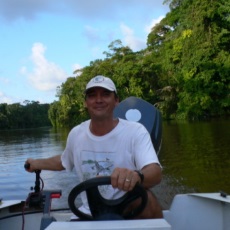 Interviewee: Daryl Loth, resident, guide and hotelier in Tortuguero
Interviewee: Daryl Loth, resident, guide and hotelier in Tortuguero
Interviewers: Martin Mowforth, Karis McLaughlin and Alice Klein
Location: Tortuguero, Costa Rica
Date: 19th August 2009
Theme: TBC
Keywords: TBC
Notes:
.
.
Martin Mowforth (MM): Re. the road about which you and Simon Tompsett wrote in an ENCA Newsletter a number of years ago, what has happened about that?
Daryl Loth (DL): The people who were pushing the road were the municipality, a couple of the diputados, were trying to push for the road to improve the economic development of the area. But it was challenged. Someone went to the Sala IV, and SETENA, who do the environmental impact assessments, had to approve the proposal and demonstrate that the road would not have any harmful effect.
Karis McLaughlin (KM): Where was this road to be from and to?
DL: I’ll show you on the map; but basically, if you go round the corner here (pointing to around the bend of the canal) and you’ll find a gasoline filling station – that{s where the electrical lines come in from the mainland. It would follow the electrical line right from Cariari potentially to that last turn before going off to La Pavona … right to the edge of the river here. So they’re talking about putting a parking lot over there and it would cut right through an extension of the National Park which connects the National Park with the wildlife refuge, land that was purchased by the European Community 16 years ago with Fundación Neotropica. It was purchased with European Union money with the local parliament to purchase the land to convert it into national park to create a biological corridor. And then a couple of years later, someone wanted to build a road through it, which would be a giant slap in the face for the European Community.
Anyway, that’s where it stands until they can prove that it won’t have any environmental consequences.
MM: So SETENA turned it down on the grounds that it would have environmental consequences?
DL: I don’t think it even went to SETENA. It was challenged I believe in the Constitutional Court and they didn’t let it go further.
MM: OK. Well the other issue which you once explained to me on one of the treks I did with you round the Cerro, was the problem of squatters and colonizers – perhaps people who have been dispossessed elsewhere and who are looking for somewhere new. And you explained about a 30 day rule – I don’t know whether this still exists – where if they could prove that they had been on this land for 30 days or more they would be granted a kind of titling which meant that they could not be thrown off.
DL: I don’t know about the 30 days any longer, but there is a certain amount of time which must be respected. Some people move onto land and will plant fruit trees that are a few years old and will say that they have been here for this long – I’ve been here for this long, see, I planted this tree. And of course all their neighbours, who will be in the same boat as them, will be witnesses and will vouch for them. I was speaking to the folks at Caño Palma (Biological Station) just yesterday. They did a census and there are now over 300 people in the area of the Cerro. Fifteen years ago, there were none. Now there’s a school.
MM: So there’s a degree of permanence. Within the National Park (further south of there), do you have the same problem of squatters, colonizers coming in in the same way?
DL: I don’t think there are squatters in the National Park. I haven’t heard of any. The problems are with people using the buffer areas, which are demarcated as buffer areas. Now people are moving onto those and clearing those.
MM: The protection is not the same then?
DL: It’s difficult. There’s plenty of protection right here by the National Park offices where the principal entrances are, but if you’re a hunter or you’re doing something illegal, you’re not going to come in the principal entrance. There’s a 100 square miles, it’s huge, and it’s mostly bordered by people’s farms and banana plantations; so there’s an infinite number of places to come in and out.
MM: And the Cerro is one of those buffer zones is it?
DL: The Cerro is actually inside the Wildlife Refuge. (6:08) They call it the rebajo, the refugio; It’s officially inside, but the village is outside. But they push right up to the limit. They go in there with a GPS and they’ve marked it out. (6:23) People still go in, even if not in terms of settlement, but in terms of gathering wood for building things, cutting down trees and things like that; they are going in to the refuge to get their building material and firewood.
MM: Well that’s very helpful and has brought me up-to-date. So, what do you consider to be the pressures on the park at the moment in terms of this so-called development?
DL: You mean sustainable development, as opposed to raw material?
MM: I’m concerned about raw material extraction and illegal development, and whether there are any pressures from specific sectors such as hunting, or farming, or maybe the plantations?
DL: Every once in a while there are stories of people coming into this forest, coming down the river and squatting on some land, National Park land, cutting down trees and taking the wood out. It’s land that some people claim is theirs, or people sell it to them. I don’t know how legitimate they are or not. But the Park is pretty good at getting onto those people; and people do come in from the road and they hunt and they take out things.
MM: So there are no large-scale threats at the moment from big plantations or mining operations, or whatever?
DL: I believe that (8:12) that there are a couple of things where banana plantations have not respected the rule about the edge of the river – it’s supposed to be 50 metres, as I understand – in the buffer zone.
MM: The Rainforest Alliance has these standards.
DL: ISO. …. I think there’s still a lot of pressure from weekend hunters – you see people are allowed to hunt for their lives, to feed themselves. That’s legal, but some are trying to claim it’s legal and that they’re surviving on it. But they have their land cruiser and their boat on a trailer and have high-powered weapons – they’re not just taking wood pigeons, they’re taking deer and anything that moves. There are a lot of people who come just athe weekend just to bag a mapuche or a deer or a wild pig. And people start on the coast taking a few turtles, babies – right here in front of the village. Four days ago, between mile 5 and mile 18 on the public access beach, it was estimated that about 10,000 eggs were taken at night, in one night – over 100 nests were dug up by people from Limón in ocean-going flat boats. They pulled up – it was calm that night when they set out. They landed about 10 – 15 people and just dug up 100 nests.
MM: That would be for sale of the eggs?
DL: Yes. People like to have their eggs with yoke. And after a couple of weeks, they’re going to have a lot of little baby turtles in there, and people don’t like to have them in there. In the first few days, they want to buy them fresh with a yoke and white. And people from the new community at the base of the Cerro – that’s where most of the people are coming from – are involved to keep trouble off the beach, at that end out near the airport. There have been several arrests but it’s hit and miss. A lot of the people don’t survive on tourism, they are not …
MM: The people in the village are probably not involved in any way, are they?
DL: They are. There are people in the village who aren’t getting the trickle-down, and some of them – well, you have them everywhere – in every country – people who think that National Parks take their constitutional rights away. Those who hunt and gather, and so they against ……
MM: The reason I made that assumption is that there are so many people who make their living from tourism.
DL: You wouldn’t believe how many of the long-standing guides, local people, who show up at the meetings and talk about the importance of conservation and the importance of maintaining this resource that provides them with their daily bread, and at night they’ll join in the feast of the turtle or the turtle eggs. There’s one guy here who used to work for one of the hotels, one of the bigger hotels in the area, and who used to do the patrolling of the beach for the CCC to do their survey. He used to walk the full length of the beach. He got paid $75 each time he did that – four times a month. So he’s getting $300 per month which is an average Costa Rican wage. He got that for doing one day a week, and he worked for one of the biggest conservation organizations in the area, and worked for one of the foremost hotels in the area that had a reputation for conservation, and was a turtle guide. In the off-season, when the turtle season ended, someone caught him with a gill net, fishing illegally on the other side of the river, trying to catch fish. I don’t know whether he was going to sell them or what; but he had the net confiscated; he had his boat confiscated; he had his turtle guiding license revoked; he was fired from his job at the hotel; he was fired from his job at the CCC. This is the kind of mentality that some of the people here exhibit, which I find shocking.
MM: Are there any extra pressures from tourism itself on the integrity of the National Park, but also on biodiversity?
DL: Biodiversity. I would say not. I don’t think it’s affecting a lot in terms of biodiversity. They’ve gone from two cycle outboard (motors) to four cycle outboards which are a lot less …. I don’t think there are problems from the fumes or the wakes given by the boats – I don’t think there are any effects on biodiversity in the park due to those. The people walking on the trails in the park that are temporarily closed – the main trail in the park – because the footpath was getting wider and wider because people were walking off the trails to avoid the mud. They need a big cash injection in the park to build trails that people will stay on, and therefore will not have an impact on biodiversity. But it was being affected, not necessarily by numbers of people, but by people walking through and round to avoid the puddles and then turning the sides into puddles – this was destroying some of the habitat at the side. So that was happening, but the Park stopped that. And we have to raise money – and there seems to be no money in the public coffers to rebuild the trail.
MM: But in your experience, over the last 15 or 16 years that you’ve been in the area, you haven’t noticed any loss of wildlife?
DL: Not due to tourism. You’ve seen at night how the turtle tours are managed. We used to go out when there were 250 people on the beach – 10-15 people per guide – might be 20 guides – all walking up and down on the beach looking for the turtles. Then the National Park put on a limit as more and more people came. They said (16:09) OK, 400 people per night – that’s the limit – 200 from 8 till 10 pm, 100 in the public beach, 100 in the National Park. Then this was repeated from 10 till 12. That was up until about 4 years ago, I think. But the number was being exceeded – the demand was greater than the supply of spots on the beach during part of the year. So they devised a new system – they’re using a system of scouts on the beach. They have news of where the turtles are, and they manage where the groups can go – one group at a time to see a turtle. There’s a trail system just inside the National Park parallel to the beach, just inside the beach, with an exit every 100 metres. So we are not walking up and down the beach any more, we’re not tripping over logs, we’re not scaring turtles back into the ocean as we used to do, especially when we’re coming back after seeing everything, and people just want to get back home, but the turtles see us and get scared back into the water. (17:16) That’s called a false call, when they come out and …. . There are far fewer false calls now than there used to be because the tourists are only going out on the beach exactly where the turtle is – or within 50 metres of where the turtle is. So there are more people than there have ever been and there is less impact on the turtles that there has ever been. It’s a very well managed system, but I guess the walking trails are the ones where you can see the turtle tours are having an impact. (17:54) But it’s partially it’s not just for saving the trails, but it was the legal issue as well, the liability – if someone were to hurt themselves, then the National park trail was open saying that it was adequate for walking but it was not, and it could be proved that it was negligent to allow people to go out there, then it could be sued. (18:28)
MM: …
DL: There are limits to the number of boats that are allowed on the canal, (Names of rivers, canals, such as Caño Palma, Tortuguero Canal) each one has a specific number of boats that are allowed to navigate in the canal for certain time periods ……
MM: There are certainly a lot more boats now that use the electric motors. You were the first to use one.
DL: Yes, I’ve been using one now for some years.
MM: Also there were several today that were just rowing.
DL: Yes, and there are some rivers that you are only allowed to go into if you have an electric motor, and some where no four cycle motors are allowed. (19:47)
MM: Gave thanks and asked for further recommendations for interviews.
DL: One other interesting thing is a greater number of jaguar sightings recently (20:28). That could be a result of the diminishing buffer zones. What were traditionally jaguar hunting grounds are now turning into farm fields; so there’s a concentration inside the Park. So there might be more jaguars per sq km than there have ever been here. It’s nature’s balance. I was in a photo studio a couple of months back and someone was doing some re-touching of a photo of a jaguar that looked like it had a strange pose to it. I asked what kind of pose is that? Well, it’s actually been propped up by sticks and I’m air-brushing out the sticks. Oh, really, what happened? Well, some farmer in Siquirres shot the jaguar because it was eating his farm animals. A trophy picture. So this is showing us again the conflict between humans and biodiversity.
MM: Anything else you’d like to add?
DL: (21:52) One of the effects we get here is that we get agricultural chemicals washed down from the banana plantations, fungicides and vermicides and pesticides and herbicides. I think it’s the fungicide which is the one that they know in Nicaragua – nemagon.
MM: They use that because they’re exported over the Atlantic.
DL: Apparently, it causes birth defects and sterility. And they have been found at levels – in the river, coming down from the banana plantations up there – at ten times the level that in a laboratory would cause changes in protein – the synthesis of protein could lead to birth defects and genetic problems. And they’re finding levels of these toxins at ten times higher in a laboratory that would be necessary to cause these problems. We think that may be having an effect on the manatis. These heavy substances come down the river in the sediment, and when that gets churned up they are absorbed by plants which are eaten by manati; they’re absorbed by fish which are eaten by crocodiles. So it comes right into the food chain. We have seen in the past fish kills on the level of thousands. By the time they get here, they’ve been in the river for a couple of days, so finding the smoking gun is very difficult. So the banana plantations have gotten off scott-free. We all know what’s causing it, but we cannot prove beyond a reasonable doubt where the spill took place.
KM: Have there been any health effects on humans?
DL: Well, probably the biggest human health problems from agricultural runoff have been in Siquirres where their water supply has been decimated by the pineapples. One plantation was closed down – I don’t know whether it was Del Monte or who, but they were shut down by the Ministry of Health, and some of the local people were complaining about the water, and others were saying you can’t shut them down – that’s where we work.
END
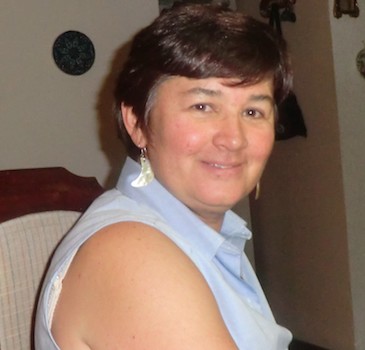 Interviewee: Patricia Blanco
Interviewee: Patricia Blanco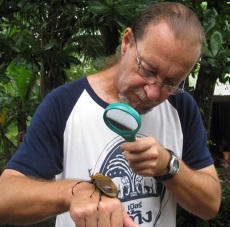 Interviewee: Ros Ballard, resident, guide and hotelier in Tortuguero
Interviewee: Ros Ballard, resident, guide and hotelier in Tortuguero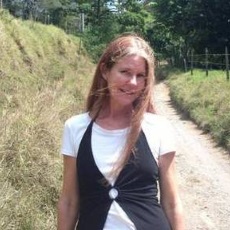 Interviewee: Isabel MacDonald, Coordinator of the Centro de Amigos Para la Paz
Interviewee: Isabel MacDonald, Coordinator of the Centro de Amigos Para la Paz Interviewee: Amilcar Castañeda, Consultant in indigenous rights to the InterAmerican Institute for Human Rights. UNED
Interviewee: Amilcar Castañeda, Consultant in indigenous rights to the InterAmerican Institute for Human Rights. UNED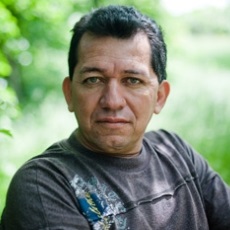 Interviewee: Didier Leiton Valverde of SITRAP Costa Rica
Interviewee: Didier Leiton Valverde of SITRAP Costa Rica Interviewee: Nela Perle
Interviewee: Nela Perle